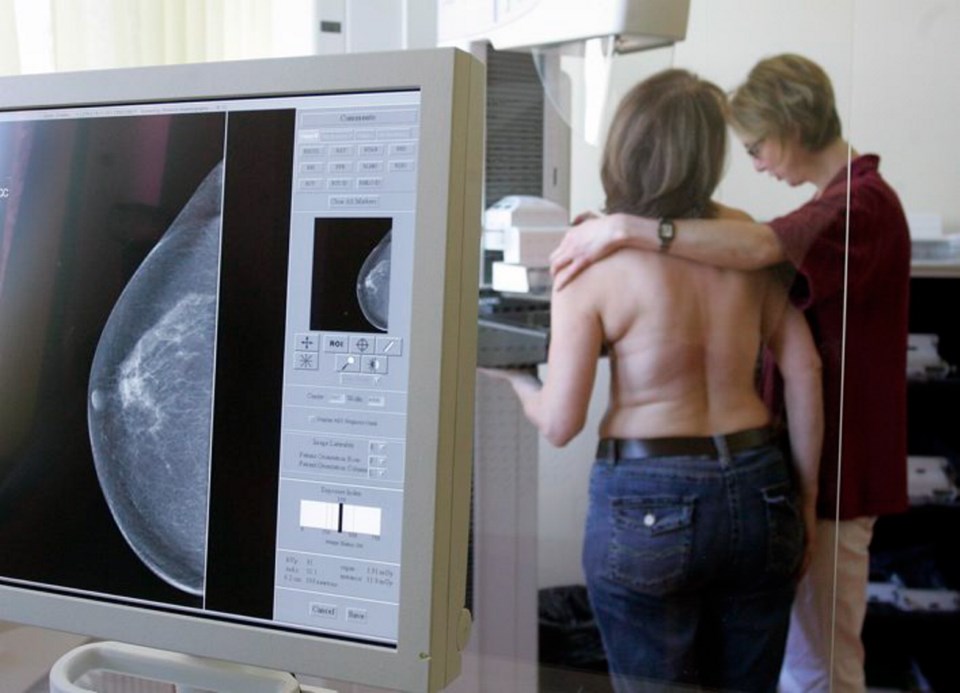Dear Dr. Roach: I recently had a screening mammogram, and received a letter from my doctor saying the results were normal. I also received a letter from the radiology department saying my breast tissue is dense, which “can make it harder to evaluate the results and also may be associated with an increased risk of breast cancer.”
Do I need to worry or have additional tests done?
S.S.
Breasts contain glandular and connective tissue, as well as adipose tissue (fat). Density in breasts refers to the amount of glandular tissue compared with adipose. As of January 2015, 21 states have adopted dense-breast legislation, which mandates that patients be informed of their breast density, that dense breast tissue may be a risk factor for breast cancer and that dense breast tissue may interfere with screening.
It would seem reasonable to consider screening tests besides mammogram, such as ultrasound. A study from December 2014 estimated that performing an ultrasound for 1,000 women with dense breasts would prevent about 0.4 deaths while causing 354 needless biopsies.
I don’t usually recommend ultrasound, but it may be appropriate in some women after a thorough evaluation of risks. The benefit of more tests might be greater for women under age 55.
Other screening tests include MRI, which is recommended only for women at very high risk (such as previous history of breast cancer or known genetic risk) due to its very high false-positive rate. Thermography, an old screening technique, has poor sensitivity and is not recommended. Digital mammography has a better ability to diagnose breast cancer, especially in dense breasts, and is preferred where available.
A newer technique tomosynthesis (sometimes called “3D mammography”) shows promise.
Dear Dr. Roach: I’ve had Crohn’s disease for the past 30 years, since I was a teenager. I’ve taken a large dose of Lomotil (I have also taken loperamide) for many years. Lomotil is controversial, but it has never caused any side effects for me. The gastroenterologists I’ve seen over the years have been reluctant to prescribe Lomotil. Why?
SW
Lomotil, a combination of diphenoxylate and atropine, is an anti-diarrheal agent. It slows down the gut, which can improve symptoms as well as improve absorption of fluids and nutrients.
However, it does not treat the underlying cause of diarrhea, and long-term use of any anti-diarrheal agent should prompt the doctor to re-evaluate why you have diarrhea and whether you are getting the best treatment.
In the case of Crohn’s disease, it’s not uncommon to need anti-diarrheal medication long-term. Most experts prefer loperamide due to its safety record, but if you haven’t had problems in 30 years with Lomotil, it’s unlikely that you will.
Dear Dr. Roach: I just returned from my annual physical. I should make it clear that if, for any reason, I am more than 10 minutes late for this appointment, I have to reschedule. I start out early and travel more than an hour for appointments. I have been this doctor’s patient for 15 years.
After 30 minutes waiting in a small, windowless, uncomfortable and cold room to see the doctor, I began to sweat and my heart raced. I opened the door and called the nurse. I said I was sick of waiting and made other remarks that I regret. Then I sat back and continued to wait.
When the doctor arrived, I voiced my feelings. To my shock, the doctor exploded with a verbal tone I never would have expected. She shouted that her practice is above and beyond the care most doctors give, that her workload with government mandates has changed her practice, making it much more difficult over the years, swearing and saying more than once: “This is not what I signed up for.” To say she was furious with me is an understatement.
I began to cry uncontrollably but got my act together enough to apologize for my comments and ask if we both could calm down and continue with the exam. She reluctantly continued with a very limited physical exam. The doctor said she felt I was so disrespectful that I should find a new doctor. I am no longer “a good fit” to be her patient. The look on her face made me feel like she wanted me to drop dead.
I left with what she called very high blood pressure, a feeling of shame that both doctor and nurse continued to place on me and a distrust of doctor-patient relationships.
Later, I realized I had been having a panic attack in the small space and lashed out in an irrational way. But from this I learned three valuable pieces of information that I would like to pass on.
First, discuss with your doctor how to handle disagreements before they happen. No two people can always agree on every issue.
Secondly, doctors should realize that some people panic in small spaces and should be aware of having a small, uncomfortable waiting room. I now am aware that I can become irrational if left in one of these cramped rooms. At my next (new) doctor visit, I will let the staff know that I can become panicked in a small room, so they will know I have a limit to how long I can be in that confined space.
Third, staff at the doctor’s office should check on any patient waiting more than 10 minutes. This would make the entire doctor visit more pleasant, with fewer complaints on everyone’s part.
I am thankful I am in good health and do not need a doctor very often. I hope my sharing this information will help other doctors and patients.
N.C.
Wow. I wish that your doctor had a small fraction of the wisdom you showed. While I understand the frustrations of being in a busy practice, there is no excuse for what your doctor did to you.



